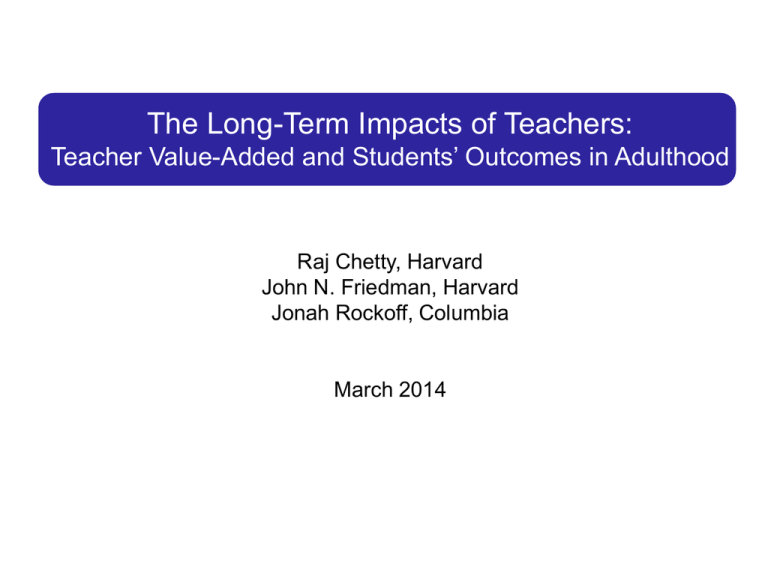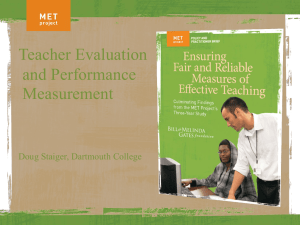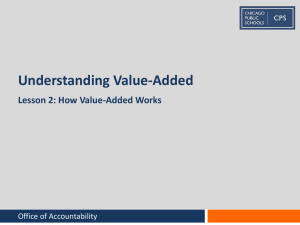PPT
advertisement

The Long-Term Impacts of Teachers: Teacher Value-Added and Students’ Outcomes in Adulthood Raj Chetty, Harvard John N. Friedman, Harvard Jonah Rockoff, Columbia March 2014 Introduction: Teacher Value-Added How can we measure and improve the quality of teaching in elementary schools? One approach: “value-added” (VA) measures [Hanushek 1971, Murnane 1975, Rockoff 2004, Rivkin et al. 2005, Aaronson et al. 2007] Rate teachers based on their students’ test score gains School districts have started to use VA to evaluate teachers, leading to considerable debate Ex: Washington D.C. lays off teachers and offers bonuses using a metric that puts 50% weight on VA measures Lawsuit in LA based on VA measures Debate About Teacher Value-Added Debate stems primarily from two intellectual issues: 1. Disagreement about whether VA measures are biased [Kane and Staiger 2008, Rothstein 2010] Do differences in test-score gains across teachers capture causal impacts of teachers or are they driven by student sorting? If VA estimates are biased, they will incorrectly reward or penalize teachers for the mix of students they get 2. Lack of evidence on teachers’ long-term impacts Do teachers who raise test scores improve students’ longterm outcomes or are they simply better at teaching to the test? Objectives of This Project This study answers these two questions by tracking one million children from childhood to early adulthood Develop new quasi-experimental tests for bias in VA estimates Test whether children who get high VA teachers have better outcomes in adulthood Results also shed light on broader issues in the economics of education What are the long-run returns to investments in better teaching? Are impacts on scores a good proxy for long-term impacts of educational interventions? Outline 1. Data 2. Construction of Value-Added Estimates with Drift 3. Evaluating Bias in Value-Added Estimates 4. Long-Term Impacts 5. Policy Implications Dataset 1: School District Data Teacher and class assignments from 1991-2009 for 2.5 million children Test scores from 1989-2009 Scaled scores standardized by grade and subject (math/reading) 18 million test scores, grades 3-8 Exclude students in special ed. schools and classrooms (6% of obs.) Dataset 2: United States Tax Data Selected data from U.S. federal income tax returns from 1996-2010 Includes non-filers via information forms (e.g. W-2’s) Student outcomes: earnings, college, teenage birth, neighborhood quality Parent characteristics: household income, 401k savings, home ownership, marital status, age at child birth Omitted variables from standard VA models Approximately 90% of student records matched to tax data Data were analyzed as part of a broader project on tax policy Research based purely on statistics aggregating over thousands of individuals, not on individual data Data Structure Student Subject Year Grade Class Teacher Test Score Raj Math 1992 4 1 Samuelson 0.5 $22K Raj English 1992 4 1 Samuelson 1.3 $22K Raj Math 1993 5 2 Solow 0.9 $22K Raj English 1993 5 2 Solow 0.1 $22K Raj Math 1994 6 3 Arrow 1.5 $22K Raj English 1994 6 4 Stigler 0.5 $22K One observation per student-subject-year Age 28 Earnings Summary Statistics Variable Mean S.D. (1) (2) Class size (not student-weighted) 28.2 5.8 Test score (SD) 0.12 0.91 Student Data: Female Age (years) 50.4% 11.7 Free lunch eligible (1999-2009) 77.1% Minority (Black or Hispanic) 72.1% English language learner 4.9% Special education 3.1% Repeating grade 2.7% Number of subject-school years per student 6.25 Student match rate to adult outcomes 89.2% Student match rate to parent chars. 94.8% 1.6 3.18 Summary Statistics Variable Adult Outcomes: Annual wage earnings at age 20 Annual wage earnings at age 25 Annual wage earnings at age 28 In college at age 20 Mean S.D. (1) (2) 5,670 17,194 20,885 35.6% 7,773 19,889 24,297 In college at age 25 16.5% College Quality at age 20 Contribute to a 401(k) at age 25 ZIP code % college graduates at age 25 Had a child while a teenager (for women) 26,408 19.1% 13.7% 14.3% 13,461 40,808 34.8% 31.3% 42.2% 28.3 0.17 34,515 Parent Characteristics: Household income (child age 19-21) Ever owned a house (child age 19-21) Contributed to a 401k (child age 19-21) Ever married (child age 19-21) Age at child birth Predicted Score 7.8 0.26 Constructing Value-Added Estimates Simplest case: teachers teach one class per year with N students All teachers have test score data available for t previous years Objective: predict test scores for students taught by teacher j in year t+1 using test score data from previous t years Constructing Value-Added Estimates Three steps to estimate VA in year t+1 1. Form residual test scores, controlling for observables Regress test scores Ais on observable student characteristics Xis, including prior test scores Ai,s-1 using within-teacher variation 2. Regress mean class-level test score residuals in year t on classlevel test score residuals in years 0 to t-1 3. Use estimated coefficients 𝜓1, … , 𝜓t to predict VA in year t+1 based on mean test score residuals in years 1 to t for each teacher j Paper generalizes this approach to allow for variation in numbers of Constructing Value-Added Estimates Practical complications: number of students varies across classes, number of years varies across teachers, multiple classes per year in middle school Generalize regression approach by estimating an autocorrelation vector and assume stationarity of teacher VA process Then form a prediction for VA in each teacher-year using data from all other years using autocorrelation vector STATA ado file to implement this procedure on the web Constructing Value-Added: Special Cases Two special cases: 1. Forecast VA in year t using data from only year t-s: where 2. Without drift, put equal weight on all prior scores. Formula collapses to standard shrinkage estimator [e.g., Kane and Staiger 2008] 0.3 0.2 0.1 0 Correlation (rs) 0.4 0.5 Autocorrelation Vector in Elementary School for English and Math Scores 0 2 4 6 8 Years Between Classes English Math 10 6 Empirical Distribution of Estimated Teacher Effects in Elementary School 0 2 Density 4 SD for English = 0.080 SD for Math = 0.116 -0.3 -0.2 -0.1 0 0.1 Teacher Value-Added English Math 0.2 0.3 0.3 0.2 0.1 0 Correlation 0.4 0.5 Autocorrelation Vector in Middle School for English and Math Scores 0 2 4 6 8 Years Between Classes English Math 10 10 Empirical Distribution of Estimated Teacher Effects in Middle School 0 2 Density 4 6 8 SD for English = 0.042 SD for Math = 0.092 -0.3 -0.2 -0.1 0 0.1 Teacher Value-Added English Math 0.2 0.3 0.1 0 -0.1 Coef. = 0.998 (0.006) -0.2 Score in Year t 0.2 Test Scores vs. Teacher Value-Added -0.2 -0.1 0 0.1 Estimated Teacher Value-Added in Year t 0.2 Part I: Bias in VA Estimates Question 1: Are VA Estimates Unbiased? Teachers’ estimated VA may reflect unobserved differences in type of students they get rather than causal impact of teacher We evaluate whether VA measures provided unbiased forecasts of teachers’ causal impacts in two ways First test: are observable characteristics excluded from VA model are correlated with VA estimates? • Ex: parent income is a strong predictor of test scores even conditional on control vector used to estimate VA • Do high VA teachers have students from higher-income families? • Combine parental background characteristics into a single predicted score using a cross-sectional regression Predicted Score in Year t -0.1 0 0.1 0.2 Predicted Scores based on Parent Chars. vs. Teacher Value-Added -0.2 Coef. = 0.002 (0.000) -0.2 -0.1 0 Teacher Value-Added Predicted Score 0.1 Actual Score 0.2 Predicted Score in Year t -0.1 0 0.1 0.2 Predicted Score Based on Twice-Lagged Score vs. Current Teacher VA -0.2 Coef. = 0.022 (0.002) -0.2 -0.1 0 Teacher Value-Added Year t-2 0.1 Year t 0.2 Estimates of Forecast Bias Using Parent Characteristics and Lagged Scores Dep. Var.: Teacher VA Score in Year t Pred. Score using Parent Chars. Score in Year t Pred. Score using Year t-2 Score (1) (2) (3) (4) 0.998 0.002 0.996 0.022 (0.0057) (0.0003) (0.0057) (0.0019) Parent Chars. Controls Observations X 6,942,979 6,942,979 6,942,979 5,096,518 Quasi-Experimental Validation: Teacher Switchers VA measures orthogonal to predictors of scores such as parent income But selection on unobservables could still be a problem (Rothstein 2010) Ideal test: out-of-sample forecasts in experiments (Kane and Staiger 2008) Does a student who is randomly assigned to a teacher previously estimated to be high VA have higher test score gains? We use teacher switching as a quasi-experimental analog Teacher Switchers in School-Grade-Subject-Year Level Data School Grade Subject Year Teachers Mean Score Mean Age 28 Earnings 1 5 math 1992 Smith, Farber, … -.09 $15K 1 5 math 1993 Smith, Farber, … -.04 $17K 1 5 math 1994 Smith, Farber, … -.05 $16K 1 5 math 1995 Mas, Farber, … 0.01 $18K 1 5 math 1996 Mas, Farber, … 0.04 $17K 1 5 math 1997 Mas, Farber, … 0.02 $18K Smith switches to a different school in 1995; Mas replaces him 0 School-Grade-Cohort Mean Test Score .02 .04 .06 Impact of High Value-Added Teacher Entry on Cohort Test Scores -3 -2 -1 0 1 Year Relative to Entry of High Value-Added Teacher Score in Current Grade 2 0 School-Grade-Cohort Mean Test Score .02 .04 .06 Impact of High Value-Added Teacher Entry on Cohort Test Scores -3 -2 -1 0 1 Year Relative to Entry of High Value-Added Teacher Score in Current Grade Score in Previous Grade 2 ∆ Score = 0.035 (0.008) ∆ TVA = 0.042 (0.002) p [∆ score = 0] < 0.001 p [∆ score = ∆ TVA] = 0.34 Number of Events = 1135 0 School-Grade-Cohort Mean Test Score .02 .04 .06 Impact of High Value-Added Teacher Entry on Cohort Test Scores -3 -2 -1 0 1 Year Relative to Entry of High Value-Added Teacher Score in Current Grade Score in Previous Grade 2 School-Grade-Cohort Mean Test Score .05 .1 .15 Impact of High Value-Added Teacher Exit on Cohort Test Scores ∆ Score = -0.045 (0.008) ∆ TVA = -0.042 (0.002) p [∆ score = 0] < 0.001 p [∆ score = ∆ TVA] = 0.66 0 Number of Events = 1115 -3 -2 -1 0 1 Year Relative to Departure of High Value-Added Teacher Score in Current Grade Score in Previous Grade 2 School-Grade-Cohort Mean Test Score -.05 -.04 -.03 -.02 -.01 0 Impact of Low Value-Added Teacher Entry on Cohort Test Scores ∆ Score = -0.021 (0.007) ∆ TVA = -0.033 (0.002) p [∆ score = 0] < 0.01 p [∆ score = ∆ TVA] = 0.09 Number of Events = 1148 -3 -2 -1 0 1 Year Relative to Entry of Low Value-Added Teacher Score in Current Grade Score in Previous Grade 2 School-Grade-Cohort Mean Test Score -.03 -.02 -.01 0 .01 .02 Impact of Low Value-Added Teacher Exit on Cohort Test Scores ∆ Score = 0.034 (0.008) ∆ TVA = 0.034 (0.002) p [∆ score = 0] < 0.001 p [∆ score = ∆ TVA] = 0.99 Number of Events = 1089 -3 -2 -1 0 1 Year Relative to Departure of Low Value-Added Teacher Score in Current Grade Score in Previous Grade 2 Changes in Scores 0 -0.05 0.05 0.1 Teacher Switchers Design: Changes in Scores vs. Changes in Mean Teacher VA -0.1 Coef. = 0.974 (0.033) -0.1 -0.05 0 0.05 Changes in Mean Teacher Value-Added 0.1 Changes in Predicted Scores 0 -0.05 0.05 0.1 Changes in Predicted Scores vs. Changes in Mean Teacher VA -0.1 Coef. = 0.004 (0.005) -0.1 -0.05 0 0.05 Changes in Mean Teacher Value-Added Score Predicted Score 0.1 Changes in Other-Subject Scores 0 -0.05 0.05 0.1 Changes in Other-Subject Scores vs. Changes in Mean Teacher VA Middle Schools Only -0.1 Coef. = 0.038 (0.083) -0.1 -0.05 0 0.05 Changes in Mean Teacher Value-Added 0.1 Changes in Other-Subject Scores 0 -0.05 0.05 0.1 Changes in Other-Subject Scores vs. Changes in Mean Teacher VA Elementary Schools Only -0.1 Coef. = 0.237 (0.028) -0.1 -0.05 0 0.05 Changes in Mean Teacher Value-Added 0.1 Estimates of Forecast Bias with Alternative Control Vectors Control Vector Quasi-Experimental Estimate of Bias (%) Baseline 2.58 (3.34) Student-level lagged scores 4.83 (3.29) Non-score controls only 45.39 (2.26) No controls 65.58 (3.73) Relation to Rothstein (2010) Findings on Sorting Rothstein result 1: Students are sorted into classrooms based on predetermined variables such as grade g-2 test scores We confirm this result in our data Rothstein result 2: Selection on observables is minimal conditional on grade g-1 controls Controlling for grade g-2 score does not affect VA estimates Consistent with our findings that VA does not predict g-2 score Rothstein notes that his findings do not imply bias in VA estimates But they raise concerns about potential selection on unobservables Our quasi-experimental teacher switcher tests indicate that selection on unobservables turns out to be modest in practice Part II: Long-Term Impacts 1 0.8 0.6 0.4 0.2 0 Impact of Current Teacher VA on Test Scores Fade-Out of Teachers’ Impacts on Test Scores in Subsequent Grades 0 1 2 Years After Current School Year Point Estimate 3 95% CI 4 Impacts on Outcomes in Adulthood Do teachers who raise test scores also improve long-term outcomes? Regress residualized long-term outcomes on teacher-level VA ′ 𝑌𝑖𝑡 = 𝛼 + κ𝑚𝑗𝑡 + 𝜂𝑖𝑡 estimates Then validate OLS estimates using cross-cohort switchers design Interpretation of these reduced-form coefficients [Todd and Wolpin 2003] Impact of having better teacher, as measured by VA, for a single year during grades 4-8 on earnings Includes benefit of better teachers, peers, etc. in later grades via 37.5 37 36.5 Coef. = 0.82% (0.07) 36 Percent in College at Age 20 38 College Attendance at Age 20 vs. Teacher Value-Added -1.5 -1 -0.5 0 0.5 Normalized Teacher Value Added (𝑚jt) 1 1.5 0.8 0.6 0.4 0.2 0 Coef. = 0.86% (0.23) -0.2 Change in College Attendance Rate Across Cohorts (%) Change in College Attendance Across Cohorts vs. Change in Mean Teacher VA -0.5 0 Change in Mean Normalized Teacher VA Across Cohorts 0.5 1 Coef. at 0 = 1.0 (0.3) Coef. at +1 equals Coef. at 0: p=0.009 0 0.5 Coef. at -1 equals Coef. at 0: p=0.050 -0.5 Impact of 1 SD Change in Leads or Lags of Mean VA (%) Event Study of Coefficients on College Attendance -4 -3 -2 -1 0 1 2 Lead or Lag of Change in Mean VA 3 4 Impacts of Teacher Value-Added on College Attendance Dependent College at College at Variable: Age 20 Age 20 College at Age 20 College Quality at Age 20 (%) (%) (%) ($) ($) ($) (%) (1) (2) (3) (4) (5) (6) (7) 0.82 (0.07) 0.71 (0.06) 0.74 (0.09) 298.63 (20.74) 265.82 (18.31) 266.17 (26.03) 0.72 (0.05) Mean of Dep. Var. 37.22 37.22 37.09 26,837 26,837 26,798 13.41 Baseline Controls X X X X X X X Value-Added Parent Chars. Controls X Lagged Score Controls Observations College Quality at Age 20 College Quality at Age 20 High Quality College X X 4,170,905 4,170,905 3,130,855 X 4,167,571 4,167,571 3,128,478 4,167,571 27000 26800 26600 Coef. = $299 (21) 26400 College Quality at Age 20 ($) 27200 College Quality (Projected Earnings) at Age 20 vs. Teacher Value-Added -1.5 -1 -0.5 0 0.5 Normalized Teacher Value Added (𝑚jt) 1 1.5 21500 21000 Coef. = $350 (92) 20500 Earnings at Age 28 ($) 22000 Earnings at Age 28 vs. Teacher Value-Added -1.5 -1 -0.5 0 0.5 Normalized Teacher Value Added (𝑚jt) 1 1.5 2 1 0 -1 Impact of 1 SD of VA on Earnings (%) 3 Impact of Teacher Value-Added on Earnings by Age 20 22 24 26 Age of Earnings Measurement Point Estimate 95% CI 28 Impacts of Teacher Value-Added on Earnings Total Wage Dependent Earnings at Earnings at Earnings at Working at Income growth Variable: Age 28 Age 28 Age 28 Age 28 at Age 28 Ages 22-28 ($) ($) ($) (%) ($) ($) (1) (2) (3) (4) (5) (6) Teacher VA Mean of Dep. Var. Baseline Controls 349.84 (91.92) 285.55 (87.64) 308.98 (110.17) 0.38 (0.16) 353.83 (88.62) 286.20 (81.86) 21,256 21,256 21,468 68.09 22,108 11,454 X X X X X X Parent Chars. Controls X Lagged Score Controls Observations X X 650,965 650,965 510,309 650,965 650,965 650,943 13 13.5 14 Coef. = -0.61% (0.06) 12.5 Percent of Women with Teenage Births 14.5 Women with Teenage Births vs. Teacher Value-Added -1.5 -1 -0.5 0 0.5 Normalized Teacher Value Added (𝑚jt) 1 1.5 14.2 14 13.8 13.6 Coef. = 0.25% (0.04) 13.4 Percent College Graduates in ZIP at Age 28 Neighborhood Quality at Age 28 vs. Teacher Value-Added -1.5 -1 -0.5 0 0.5 Normalized Teacher Value Added (𝑚jt) 1 1.5 20.5 20 19.5 Coef. = 0.55% (0.16) 19 Percent Saving for Retirement at Age 28 Retirement Savings at Age 28 vs. Teacher Value-Added -1.5 -1 -0.5 0 0.5 Normalized Teacher Value Added (𝑚jt) 1 1.5 Heterogeneity in Impacts of 1 SD of Teacher VA by Demographic Group Dependent Variable: Value-Added Mean College Quality Impact as % of Mean College Quality at Age 20 ($) (2) Low Income (3) High Income (4) 290.65 (23.61) 237.93 (21.94) 190.24 (19.63) 27,584 26,073 1.05% 0.91% Girls Boys (1) (5) NonMinority (6) 379.89 (27.03) 215.51 (17.09) 441.08 (42.26) 23,790 30,330 23,831 33,968 0.80% 1.25% 0.90% 1.30% Minority Heterogeneity in Impacts of 1 SD of Teacher VA by Subject Dependent Variable: College Quality at Age 20 ($) Elementary School (1) (2) (3) Math Teacher Value-Added English Teacher Value-Added Control for Average VA in Other Subject 207.81 (21.77) 106.34 (28.50) 258.16 (25.42) Middle School (4) (5) 265.59 (43.03) 189.24 (33.07) 521.61 (63.67) X X Teacher Impacts by Grade Reduced-form impacts of having better teachers in each grade include tracking to better teachers in future grades We can net-out the impact of tracking from the reduced-form coefficients by estimating tracking process Estimate impact of current teacher VA on VA of future teachers Subtract out impacts of future teachers 800 600 400 200 0 Impact of 1 SD of VA on College Quality ($) Effect of Value-Added on Earnings by Grade 4 5 Reduced-Form Coefficients 6 Grade Net of Teacher Tracking 7 8 95% CI for Reduced-Form Policy Implications Policy Proposal 1: Deselection of Low VA Teachers What are the gains from replacing teachers with VA in bottom 5% with teachers of median quality (Hanushek 2009)? Policy Calculations Use estimates to evaluate gains from improving teacher quality Measure impact of teacher VA on present value of lifetime earnings Assumptions Ignore general equilibrium effects and non-monetary gains [Oreopoulos and Salvanes 2011, Heckman 2000] Constant percentage impact on earnings over life Life-cycle earnings follows cross-sectional life-cycle path in 2010 2% wage growth with 5% discount rate back to age 12 Undiscounted lifetime earnings gains are roughly 5 times larger Policy Calculations Consider replacing teachers in the bottom 5% of VA distribution with teachers of average quality (Hanushek 2009) Select on true VA NPV gain for a class of average size: $407,000 In practice, gains are reduced by two factors Estimation error in VA Drift in VA over time Deselecting Teachers on the Basis of Value-Added 0.04 Density 0.03 0.02 0.01 0 0 -0.3 -0.2 -0.1 0 0.1 0.2 0.3 Teacher Effect on Test Scores Population Observed Below 5th Percentile After 3 Years Deselecting Teachers on the Basis of Value-Added 0.04 Density 0.03 Only 3% of teachers deselected using estimated VA with three years of data are above average in true VA 0.02 0.01 0 0 -0.3 -0.2 -0.1 0 0.1 0.2 0.3 Teacher Effect on Test Scores Population Observed Below 5th Percentile After 3 Years Earnings Impact in First Year After Deselection Based on Estimated VA Lifetime Earnings Gain Per Class ($1000s) 0 100 200 300 400 Present Value Gain from Deselection on True VA = $406,988 0 2 4 6 Number of Years Used to Estimate VA 8 10 Lifetime Earnings Gain Per Class ($1000s) 0 100 200 300 400 Deselection Based on Estimated VA After 3 Years: Earnings Impacts in Subsequent Years Average 10 Year Gain = $184,234 1 2 3 4 5 6 7 8 9 10 School Years Since Teacher Was Hired 11 12 13 Lifetime Earnings Gain Per Class ($1000s) 0 100 200 300 400 Earnings Impact Over Time Average 10 Year Gain = $246,744 Average 10 Year Gain = $184,234 1 2 3 4 5 6 7 8 9 10 11 12 13 School Years Since Teacher Was Hired Deselected on Estimated VA in Year 4 Deselected on True VA in Year 4 Costs vs. Benefits of VA-Based Evaluation Rothstein (2013) estimates that deselecting bottom 5% of teachers based on VA would require a salary increase of $700 for all teachers Avg. gain from deselection policy is $184,000 x 5% = $9,250 Gain 10 times as large as cost VA could be a useful policy tool Key concern: gains may be eroded when VA is actually used Using VA in high-stakes evaluation could lead to teaching to the test or cheating [Jacob 2005, Neal and Schanzenbach 2010, Barlevy and Neal 2012] Broader policy lesson: improving teacher quality, whether through VA Policy Implications Policy Proposal 2: Retention of High VA Teachers What are the gains from increasing retention of high valueadded teachers by paying salary bonuses? Gains from Retaining High VA Teachers Retaining a teacher whose VA is at the 95th percentile (based on 3 years of data) for an extra year would generate PV earnings gain of $266K Clotfelter et al. (2008) analyze impacts of bonus payments to teachers $1,800 bonus would raise teacher retention by 1.5 percentage points earnings gain of $3,200 Net return relatively small because most of the bonus payments go to teachers who would not have left anyway Have to pay bonuses to 60 teachers to retain 1 teacher on average Conclusion Further work needed to assess value-added as a policy tool Using VA measures in high-stakes evaluation could induce negative behavioral responses such as teaching to the test or cheating Errors in personnel decisions must be weighed against mean benefits Results highlight large potential returns from developing policies to improve teacher quality From a purely financial perspective, parents should be willing to pay about $7,000/year to get a 1 SD higher VA teacher for their child Appendix Figures Percentile Ranking Based on Earnings at Age 23 or 27 0 20 40 60 80 100 Rankings of Colleges Based on Earnings at Ages 23 and 27 vs. Age 32 0 20 40 60 80 Percentile Ranking of College Based on Earnings at Age 32 Age 23 Age 27 100 1 0.9 0.8 0.7 0.6 0.5 Correlation with Ranking Based on Earnings at Age 32 Correlation of College Rankings Based on Earnings at Age 32 With Rankings Based on Earnings at Earlier Ages 23 25 27 29 Age at Which Earnings are Measured 31 Correlation of Earnings at Age x with Earnings at Age x+12 .1 .2 .3 .4 .5 .6 Correlation of Individual Earnings with Earnings 12 Years Later, by Age 20 30 40 Age 50 60 Percent Attending College at Age 20 0% 20% 40% 60% 80% College Attendance -2 -1 0 Test Score (SD) No Controls 1 With Controls 2 20 College Quality at Age 20 ($1000) 25 30 35 40 45 College Quality -2 -1 0 Test Score (SD) No Controls 1 With Controls 2 10 Earnings at Age 28 ($1000) 20 30 40 Earnings -2 -1 0 1 Test Score (SD) No Controls With Controls 2 20% 15% 10% 5% Percent of Females with Teenage Birth 25% Teenage Birth -2 -1 0 Test Score (SD) No Controls 1 With Controls 2 25 20 15 10 5 0 Percentage of Jacob and Levitt (2003) Outliers Jacob and Levitt (2003) Proxy for Test Manipulation vs. Value-Added Estimates 0 20 40 60 Percentile of Teacher Value-Added 80 100








